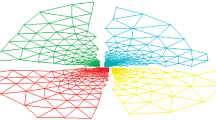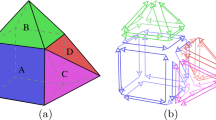Abstract
The scalable execution of parallel adaptive analyses requires the application of dynamic load balancing to repartition the mesh into a set of parts with balanced work load and minimal communication. As the adaptive meshes being generated reach billions of elements and the analyses are performed on massively parallel computers with 100,000’s of computing cores, a number of complexities arise that need to be addressed. This paper presents procedures developed to deal with two of them. The first is a procedure to support multiple parts per processor which is used as the mesh increases in size and it is desirable to partition the mesh to a larger number of computing cores than are currently being used. The second is a predictive load balancing method that sets entity weights before dynamic load balancing steps so that the mesh is well balanced after the mesh adaptation step thus avoiding excessive memory spikes that would otherwise occur during mesh adaptation.















Similar content being viewed by others
References
Flaherty J, Loy R, Özturan C, Shephard M, Szymanski B, Teresco J, Ziantz L (1996) Parallel structure and dynamic load balancing for adaptive finite element computation. Appl Numer Math 26:241–263
Shephard M, Flaherty J, Bottasso C, de Cougny H, Ozturan C, Simone M (1997) Parallel automated adaptive analysis. Parallel Comput 23:1327–1347
Sahni O, Zhou M, Shephard M, Jansen K (2009) Scalable implicit finite element solver for massively parallel processing with demonstration to 160k cores. In: Proceedings of the SC09. Springer, Berlin
Shephard M, Jansen K, Sahni O, Diachin L (2007) Parallel adaptive simulations on unstructured meshes. J Phys Conf Ser 78:012053
Zhou M, Sahni O, Kim H, Figueroa C, Taylor C, Shephard M, Jansen (2010) Cardiovascular flow simulation at extreme scale. Comput Mech 46:71–82 doi:10.1007/s00466-009-0450-z
Zhou M, Sahni O, Shephard M, Devine K, Jansen K (2010) Controlling unstructured mesh partitions for massively parallel simulations. SIAM J Sci Comput 32(6):3201–3227
Beall MW, Shephard MS (1997) A general topology-based mesh data structure. Int J Numer Methods Eng 40:1573–1596
Celes ERW, Paulino GH (2005) A compact adjacency-based topological data structure for finite element mesh representation. Int J Numer Methods Eng 64:1529–1565
Garimella R (2002), Mesh data structure selection for mesh generation and fea applications. Int J Numer Methods Eng 55:451–478
Seol E, Shephard M (2006) Efficient distributed mesh data structure for parallel automated adaptive analysis. Eng Comput 22(3–4):197–213
Chand K, Diachin L, Li X, Ollivier-Gooch C, Seol E, Shephard M, Tautges T, Trease H (2008) Toward interoperable mesh, geometry and field components for PDE simulation development. Eng Comput 24(2):165–182
Devine K, Diachin L, Kraftcheck J, Jansen KE, Leung V, Luo X, Miller M, Ollivier-Gooch C, Ovcharenko A, Sahni O, Shephard M, Tautges T, Xie T, Zhou M (2009) Interoperable mesh components for large-scale, distributed-memory simulations. J Phys Conf Ser 180:012011
Boman E, Devine K, Fisk L, Heaphy R, Hendrickson B, Leung V, Vaughan C, Catalyurek U, Bozdag D, Mitchell W (1999) Zoltan home page. http://www.cs.sandia.gov/Zoltan
Devine K, Boman E, Heaphy R, Hendrickson B, Vaughan C (2002) Zoltan data management services for parallel dynamic applications. Comput Sci Eng 4(2):90–97
Devine K, Boman E, Heaphy R, Bisseling R, Catalyurek U (2006) Parallel hypergraph partitioning for scientific computing. In: Proceedings of 20th international parallel and distributed processing symposium (IPDPS06), IEEE
Karypis G, Kumar V (1999) Parallel multilevel k-way partitioning scheme for irregular graphs. SIAM Rev 41(2):278–300
Pellegrini F (2007) Scotch 5.0 user’s guide. Tech. rep., LaBRI
Walshaw C, Cross M (2007) JOSTLE: parallel multilevel graph-partitioning software—an overview. In: Mesh partitioning techniques and domain decomposition techniques, pp 27–58
Teresco J, Devine K, Flaherty J (2005) Partitioning and dynamic load balancing for the numerical solution of partial differential equations. In: Numerical solution of partial differential equations on parallel computers. Springer, Berlin
Karypis G, Kumar V (1996) A parallel algorithm for multilevel graph partitioning and sparse matrix ordering. In: 10th intlernational parallel processing symposium, pp 314–319
Karypis G, Kumar V (1998) Multilevel algorithms for multi-constraint graph partitioning. In: Proceedings of the 1998 ACM/IEEE conference on supercomputing, pp 1–13
Womersley J (1955) Method for the calculation of velocity, rate of flow and viscous drag in arteries when the pressure gradient is known. J Physiol 127:553–563
Vignon-Clementel I, Figueroa C, Jansen K, Taylor C (2006) Outflow boundary conditions for three-dimensional finite element modeling of blood flow and pressure in arteries. Comput Methods Appl Mech Eng 195(29–32):3776–3796
Flaherty J, Loy R, Shephard M, Szymanski B, Teresco J, Ziantz L (1997) Predictive load balancing for parallel adaptive finite element computation. In: Proceedings of the international conference on parallel and distributed processing techniques and applications, PDPTA’97, vol 1, pp 460–469
Oliker L, Biswas R, Strawn R (1996) Parallel implementation of an adaptive scheme for 3D unstructured grids on the SP2. In: Proceedings of the 3rd international workshop on parallel algorithm for irregularly structured problems
Li X, Shephard M, Beall M (2005) 3D anisotropic mesh adaptation by mesh modification. Comput Methods Appl Mech Eng 194:4915–4950
Sahni O, Müller Y, Jansen K, Shephard M, Taylor C (2006) Efficient anisotropic adaptive discretization of the cardiovascular system. Comput Methods Appl Mech Eng 195:5634–5655
Borouchaki H, George P, Hecht F, Laug P, Saltel E (1997) Delaunay mesh generation governed by metric specifications. part i. algorithms. Finite Elem Anal Des 25(1–2):61–83
Frey P, George PL, Hecht F (2008) Mesh generation: application to finite elements, 2nd edn. ISTE, London
Labbe P, Dompierre J, Vallet M-G, Guibault F, Trpanier J-Y (2004) A universal measure of the conformity of a mesh with respect to an anisotropic metric field. Int J Numer Methods Eng 61(16):2675–2695
Li X (2003) Mesh modification procedures for general 3D non-manifold domains. Ph.D. thesis, Rensselaer Polytechnic Institute
Pain C, Umpleby A, de Oliveira C, Goddard A (2001) Tetrahedron mesh optimization and adaptivity for steady-state and transient finite element calculations. Comput Methods Appl Mech Eng 190:3771–3796
Acknowledgments
We gratefully acknowledge the support of this work by NSF’s PetaApps program under grant OCI-0749152 and by the DOE Office of Science’s SciDAC/ITAPS program under grant DE-FC02-06ER25769. This research used computing resources provided by: (a) Rensselaer’s Computational Center for Nanotechnology Innovations that is funded by the State of New York, IBM and Rensselaer Polytechnic Institute, (b) Argonne Leadership Computing Facility at Argonne National Laboratory, which is supported by the Office of Science of the DOE under contracts DE-AC02-06CH11357, and (c) NSF through TeraGrid resources provided by National Institute for Computational Sciences (NICS); Kraken system was used. We would like to acknowledge that results presented in this article made use of software components provided by ACUSIM Software Inc. and Simmetrix Inc.
Author information
Authors and Affiliations
Corresponding author
Rights and permissions
About this article
Cite this article
Zhou, M., Xie, T., Seol, S. et al. Tools to support mesh adaptation on massively parallel computers. Engineering with Computers 28, 287–301 (2012). https://doi.org/10.1007/s00366-011-0218-x
Received:
Accepted:
Published:
Issue Date:
DOI: https://doi.org/10.1007/s00366-011-0218-x




